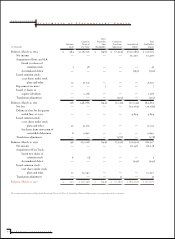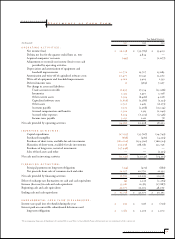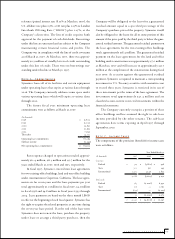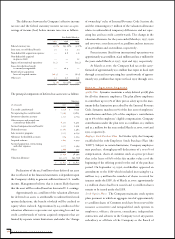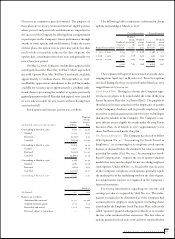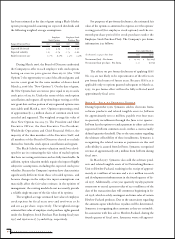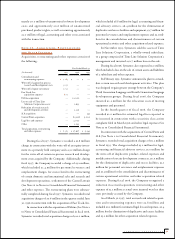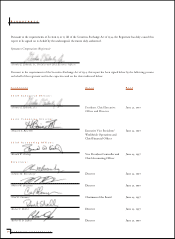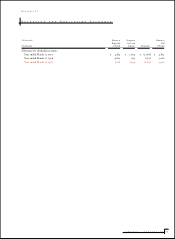Symantec 1997 Annual Report Download - page 52
Download and view the complete annual report
Please find page 52 of the 1997 Symantec annual report below. You can navigate through the pages in the report by either clicking on the pages listed below, or by using the keyword search tool below to find specific information within the annual report.
50 SYMANTEC CORPORATION
has been estimated at the date of grant using a Black-Scholes
option pricing model assuming no expected dividends and
the following weighted average assumptions:
Employee Employee Stock
Stock Options Purchase Plan
Range of Exercise Prices 1997 1996 1997 1996
Expected life (years) 4.34 4.34 0.50 0.50
Expected volatility 0.63 0.74 0.74 0.60
Risk free interest rate 6.7% 6.0% 5.4% 5.4%
During March 1996, the Board of Directors authorized
the Company to offer to each employee with stock options
having an exercise price greater than $13.10 (the “Old
Options”) the opportunity to cancel the affected grants and
receive a new grant for the same number of shares dated
March 4, 1996 (the “New Options”). On the date of grant,
the New Options have an exercise price equal to $13.10 and a
stock price of $12.63. Under the terms of this stock option
cancellation and regrant, all options began vesting as of the
new grant date and no portion of any regranted options were
exercisable until March 4, 1997. Options representing a total
of approximately 2.3 million shares of common stock were
canceled and regranted. The weighted average fair value of
these New Options was $14.79. The President and Chief
Executive Officer, the then Executive Vice President,
Worldwide Operations and Chief Financial Officer, the
majority of the then members of the Executive Staff, and
all members of the Board of Directors elected to exclude
themselves from this stock option cancellation and regrant.
The Black-Scholes option valuation model was devel-
oped for use in estimating the fair value of traded options
that have no vesting restrictions and are fully transferable. In
addition, option valuation models require the input of highly
subjective assumptions, including the expected stock price
volatility. Because the Company’s options have characteristics
significantly different from those of traded options, and
because changes in the subjective input assumptions can
materially affect the fair value estimate, in the opinion of
management, the existing models do not necessarily provide
a reliable single measure of the fair value of its options.
The weighted-average estimated fair value of employee
stock options for fiscal years 1997 and 1996 were $7.81
and $10.44 per share, respectively. The weighted-average
estimated fair value of employee stock purchase rights granted
under the Employee Stock Purchase Plan during fiscal years
1997 and 1996 were $7.74 and $18.94, respectively.
For purposes of pro forma disclosures, the estimated fair
value of the options is amortized to expense over the options’
vesting period (for employee stock options) and the six-
month purchase period (for stock purchases under the
Employee Stock Purchase Plan). The Company’s pro forma
information is as follows:
Year ended March 31,
(In thousands, except per share data) 1997 1996
Net income (loss) - Pro forma $14,123 $ (47,015)
Net income (loss) per share - Pro forma 0.27 (0.89)
The effects on pro forma disclosures of applying SFAS
No. 123 are not likely to be representative of the effects on
pro forma disclosures of future years. Because SFAS 123 is
applicable only to options granted subsequent to March 31,
1995, its pro forma effect will not be fully reflected until
approximately fiscal 2000.
Note 9. Sale of Product Rights
During September 1996, Symantec sold its electronic forms
software products and related tangible assets to JetForm
for approximately $100.0 million, payable over four years
in quarterly installments through the June 2000 quarter.
JetForm has the option to tender payment in either cash or in
registered JetForm common stock, within a contractually
defined quantity threshold. Due to the uncertainty regarding
the ultimate collectibility of these installments, Symantec is
recognizing the related revenue as payments are due and
collectibility is assured from JetForm. Symantec recognized
revenue of approximately $18.3 million from JetForm during
fiscal 1997.
In March 1997, Symantec also sold the software prod-
ucts and related tangible assets of its Networking Business
Unit to Hewlett-Packard, resulting in the receipt of approxi-
mately $1.0 million of revenue and a $2.0 million research
and development reimbursement in the fourth quarter of fis-
cal 1997. Additionally, a two year quarterly royalty payment
stream not to exceed a present value of $27.0 million as of the
date of the transaction date will commence beginning in fis-
cal 1998, which is solely contingent on future sales of certain
Hewlett-Packard products. Due to the uncertainty regarding
the amounts upon which these royalties will be determined,
Symantec is recognizing these amounts as they are estimable.
In association with this sale to Hewlett-Packard, during the
fourth quarter of fiscal 1997, Symantec wrote off approxi-


